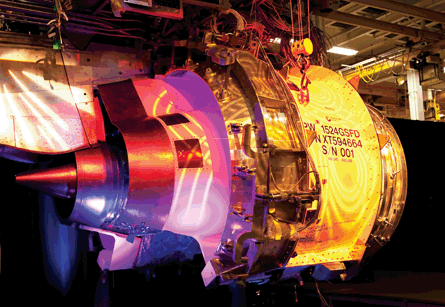The partnering of engine makers Pratt & Whitney and Rolls-Royce gives the venture an expanded palette of power options for new narrow-body aircraft in the 2020 timeframe and beyond. From second-generation geared turbofans (GTFs) to open rotor and other exotic architectures, the teaming brings together many of the needed components to address the technology challenges ahead.
Through P&W, Rolls-Royce may gain entry into the second generation (aka, N+2) GTF design, which will likely boost propulsive efficiency by increasing the bypass ratio as high as 20:1, up from as much as 12:1 for the first-generation (N+1) GTF for the Bombardier CSeries. Rolls-Royce chose not to compete with the more traditionally architected CFM Leap-X turbofan offering or the PW1000G-series GTF engines for the re-engined Airbus A320neo and Boeing 737 Max, effectively ending its interest in the narrowbody segment in the near future.
With the P&W partnership, if approved, R-R expects to compete for an expected 20,000 new clean-sheet midsize twin-engine aircraft in the 120-230 passenger range over the next 20 years. Having two highly efficient designs at high technology readiness levels - the second- or third-generation GTF and the open rotor - the partners should be able to offer airframers maximum flexibility for any clean-sheet design, gaining an edge on the competition.
 |
|---|
© Pratt & Whitney |
R-R has been industrious while P&W and CFM fought for re-engining deals, immersing itself in advanced research work internally and with European partners through a variety of programs. Like CFM, the company considers open rotors to be a "game changer" in the single-aisle market, assuming issues with noise, installation and weight can be overcome. A long list of patent applications from R-R engineers filed this year feature a heavy emphasis on aerofoil, rotor and actuator technologies, many of which are ingredients for an open rotor engine. For its more traditional engines, R-R will continue its own Advance 2 program, featuring two-shaft designs in the 16,000-25,000lb-thrust (70-110kN) range and the Advance 3 three-shaft engine for large narrowbodies and widebody aircraft.
For open rotors, R-R is investigating the architecture internally as well as with partners as part of the sustainable green engine (SAGE) programme, and the validation of radical engine architecture systems (DREAM) programme, a four-year European Union-funded engine technology project headed by R-R and made up of 44 international partners. For DREAM, which comes to a close in January, the experiments and studies were aimed at reducing specific fuel consumption (SFC) and CO2 emissions by 27% (compared with 2000-era engines) while cutting community noise by 9dB. Technologies investigated included new approaches to whole-engine architecture plus geared and direct-drive open rotor analyses.
A geared open-rotor project seems particularly suited to P&W input. Both Pratt & Whitney and GE, CFM's joint-venture parent, tested open rotor engines on flight test aircraft in the early 1980s.
Open rotor designs can push propulsive efficiency perhaps as high as almost 93% compared to 70-80% for today's high-bypass engines. A shrouded turbofan like the GTF, in theory, can reach a propulsive efficiency of about 87%, but at the expense of a very large-diameter fan and shroud structure.
In partnering with Pratt, R-R could gain access to at least three key elements of the open rotor engineering challenge - P&W's high-torque gearing system experience from the GTF, P&W sister-company Hamilton Sundstrand's variable-pitch propeller mechanisms, which would likely be needed to control the blade pitch on the twin contra-rotating rotors, and, assuming the acquisition goes through, Goodrich's expertise with nacelles. These are critical to make the value proposition work out for an open rotor because non-optimal integration of engine and airframe can greatly increase fuel burn. For its part, P&W will likely benefit from much of the difficult research and development around open rotor technology already having been completed.
Source: Flight International



















